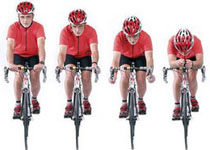SCx = 0.40 for a traditional cyclist with tense arms
SCx = 0.35 for a traditional cyclist with bent arms
SCx = 0.30 for a traditional cyclist with hands at the bottom of the handlebar
SCx = 0.25 for a cyclist "against time" or triathlete

Resistance of the air in cycling
For a cyclist, the resistance of the air increases with the speed.
This resistance does not depend on the cyclist weight but depends on several parameters not always well perceived.
Cyclist's speed
The resistance of the air Ra is proportional to the square of the speed relative to the air Va.
The speed relative to the air corresponds to the real speed of the cyclist plus (resp. minus) the speed of the front wind (resp. back wind).
Consequently, going twice as fast requires eight more power (cube of the speed), then eight more force on the pedals.
Weather conditions
The resistance of the air is proportional to the air density ρ which depends on the weather conditions.
It is lower when the air is warm or when the atmospheric pressure is low (bad weather, high altitude).
Aerodynamic profile
The resistance of the air is proportional to the frontal area of the cyclist S and the coefficient of aerodynamic shape Cx.
The frontal area depends on the morphology (size, shoulder width, etc.), but essentially the position of the cyclist.
The coefficient of aerodynamic shape is proper to the air flow (bike, helmet, clothes, etc.).
The product of these two elements defines the penetration coefficient SCx.
| For a road cyclist, we can consider: SCx = 0.40 for a traditional cyclist with tense arms SCx = 0.35 for a traditional cyclist with bent arms SCx = 0.30 for a traditional cyclist with hands at the bottom of the handlebar SCx = 0.25 for a cyclist "against time" or triathlete |
 |
Calculation formula
In summary, the mathematic formula allowing calculation is:
Ra = ½ ρ SCx Va²
Calculation of the cycling power
J.L